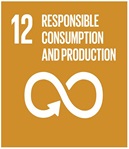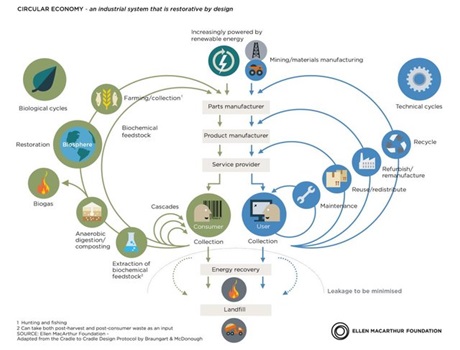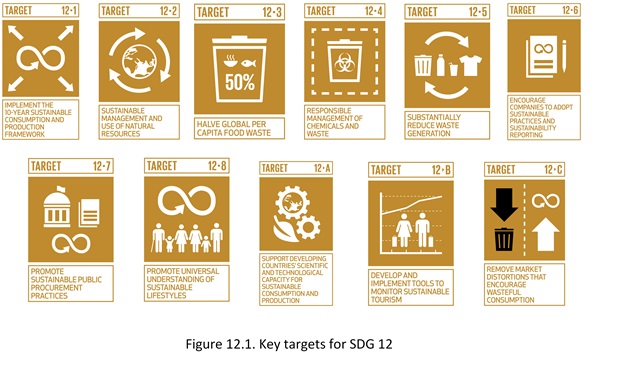Sustainable Development Goal (SDG 12): ‘Responsible Consumption and Production’ - Engineers are in the forefront of developing solutions
By Eng. (Dr.) Saja A. A. Majeed
 Sustainable Consumption and Production (SCP) cuts across many sectors such as air, water and sanitation, energy and waste. It has a closer link to many sectors related to economy including food, transport, tourism, construction and health. An economic growth of a nation or a community should not cause an ecological crisis as a result of extensive levels of extraction, production, and consumption. Responsible consumption and production needs to start with every citizen and organization. We need to be a role model as an engineer and an engineering organization that will prompt others and other organizations to change the way they behave and work so that we can achieve a good economic growth without an ecological crisis. In all possible ways, we need to start immediately modelling our own institutions with innovative initiatives toward sustainable consumption and production. Starting a smaller action will always have a bigger impact and certainly create a greater momentum with a chain of self-awareness, than waiting for a large-scale project to kick off.
Sustainable Consumption and Production (SCP) cuts across many sectors such as air, water and sanitation, energy and waste. It has a closer link to many sectors related to economy including food, transport, tourism, construction and health. An economic growth of a nation or a community should not cause an ecological crisis as a result of extensive levels of extraction, production, and consumption. Responsible consumption and production needs to start with every citizen and organization. We need to be a role model as an engineer and an engineering organization that will prompt others and other organizations to change the way they behave and work so that we can achieve a good economic growth without an ecological crisis. In all possible ways, we need to start immediately modelling our own institutions with innovative initiatives toward sustainable consumption and production. Starting a smaller action will always have a bigger impact and certainly create a greater momentum with a chain of self-awareness, than waiting for a large-scale project to kick off.
A national policy on SCP was published in 2019 to drive an integrated and a cross cutting policy in the sectors that involve consumption/production of a good or service. We need such a policy and that in practice which leads us to send zero trash to open dumps and eliminate deforestation from our projects. Many circular economy models have emerged over the past decade, which ultimately aim to promote an industrial system that is restorative or regenerative by intention and design; it replaces the ‘end-of-life’ concept with restoration; shifts towards a number of ‘R’s as strategies (EMF 2013). Figure 13.1 shows one such model
 Figure 13.1. The Butterfly Diagram for Circular Economy by Ellen MacArthur Foundation (2013).
.
Figure 13.1. The Butterfly Diagram for Circular Economy by Ellen MacArthur Foundation (2013).
.
Every SDG needs engineers. How can engineers contribute to attain Sustainable Development Goal (SDG) 12 – ‘Responsible Consumption and Production’, which is to ensure sustainable consumption and production patterns. The activities under SDG 12 include various sectors and themes and have obvious engineering relevance and requirements associated with them. Recently, a resource pack on sustainable consumption and production has been introduced to the universities and tertiary sector in Sri Lanka as modules/ credits or as orientation programmes. There have been many initiatives in Sri Lanka such as SWITCH-Asia Sustainable Consumption and Production National Policy Support Component funded by European Union (EU), which also created a SCP forum in Sri Lanka to educate, promote, and act as a hub for SCP initiatives in the country (http://scp.lk/). Successful implementation of SCP policy also requires an enabling environment with key strategies in education and communication, science and technology, and public procurement. Engineers are in the forefront who help accelerate many business-driven innovations and entrepreneurship initiatives, for example through innovative manufacturing and production hubs that can scale the nation to a circular economy pathway.
Global key figures related to ‘Responsible Consumption and Production’ (SDG12)
Some of the relevant global key figures related to ‘Responsible Consumption and Production’ provided in the United Nation statistics include (https://sdgs.un.org/goals/goal12):
- Each year equivalent to 1.3 billion tonnes worth of food [around $1 trillion] ends up rotting in the bins of consumers and retailers, or spoiling due to poor transportation and harvesting practices (Estimated to be one third of all food produced).
- The natural resources have been used unsustainably across the globe (In 2010, global material footprint was estimated to be 73.2 billion tonnes, which increased to 85.9 billion tonnes in 2017).
- Between 2010-2019, electronic waste grew by 38%, but less than 20% is recycled, which is expected to grow to 9.0 kg per capita in 2030 (Increase of 0.16 kg per capita annually).
- 13.8% of food is lost in supply chains, from harvesting, transport, storage and to processing before reaching the retail sales (2016).
SDG 12 (Responsible Consumption and Production) targets
SDG 12 sets out eight key targets and three additional targets (12.a, 12.b, and 12.c) for resource mobilisation and policy to be achieved by 2030. The eleven key targets are:
12.1 Implement the 10-year framework of programmes on sustainable consumption and production, all countries taking action, with developed countries taking the lead, taking into account the development and capabilities of developing countries
12.2 By 2030, achieve the sustainable management and efficient use of natural resources
12.3 By 2030, halve per capita global food waste at the retail and consumer levels and reduce food losses along production and supply chains, including post-harvest losses
12.4 By 2020, achieve the environmentally sound management of chemicals and all wastes throughout their life cycle, in accordance with agreed international frameworks, and significantly reduce their release to air, water and soil in order to minimize their adverse impacts on human health and the environment
12.5 By 2030, substantially reduce waste generation through prevention, reduction, recycling and reuse
12.6 Encourage companies, especially large and transnational companies, to adopt sustainable practices and to integrate sustainability information into their reporting cycle
12.7 Promote public procurement practices that are sustainable, in accordance with national policies and priorities
12.8 By 2030, ensure that people everywhere have the relevant information and awareness for sustainable development and lifestyles in harmony with nature
12.A Support developing countries to strengthen their scientific and technological capacity to move towards more sustainable patterns of consumption and production
12.B Develop and implement tools to monitor sustainable development impacts for sustainable tourism that creates jobs and promotes local culture and products
12.C Rationalize inefficient fossil-fuel subsidies that encourage wasteful consumption by removing market distortions, in accordance with national circumstances, including by restructuring taxation and phasing out those harmful subsidies, where they exist, to reflect their environmental impacts, taking fully into account the specific needs and conditions of developing countries and minimizing the possible adverse impacts on their development in a manner that protects the poor and the affected communities
 .
.
SDG 12 (Responsible Consumption and Production) target indicators (examples)
The achievement of ‘Responsible Consumption and Production’ goal is measured by the following set of key indicators:
- Number of countries with sustainable consumption and production (SCP) national action plans or SCP mainstreamed as a priority or a target into national policies
- Domestic material consumption, domestic material consumption per capita, and domestic material consumption per GDP
- Global food loss index
- Number of parties to international multilateral environmental agreements on hazardous waste, and other chemicals that meet their commitments and obligations in transmitting information as required by each relevant agreement
- Hazardous waste generated per capita and proportion of hazardous waste treated, by type of treatment
- National recycling rate, tons of material recycled
- Number of companies publishing sustainability reports
- Number of countries implementing sustainable public procurement policies and action plans
- Extent to which (i) global citizenship education and (ii) education for sustainable development (including climate change education) are mainstreamed in (a) national education policies; (b) curricula; (c) teacher education; and (d) student assessment
Detail indicator descriptions are available at https://unstats.un.org/sdgs
Current status of SDG 12 progression in Sri Lanka
The current status of achieving SDG 12 in Sri Lanka was reported in the recent review by the Government of Sri Lanka (SLVNR 2018). Some of the key contributions include:
- Material footprint in Sri Lanka is 1.4 kg per unit of GDP in 2017 and domestic material consumption increased from 3.1 metric tons per capita in 2000 to 5.6 metric tons per capita in 2017
- The five-year Action Plan for 2015 – 2020 prepared by the Western Province Waste Management Authority aims to increase the recycling rate of solid waste up to 38% by 2020 from 17% in 2015
- In Sri Lanka, Municipal Solid Waste generation is 1.9 kg/capita/day as of 2016 data
- Electronic waste generation sharply increased from 1.5 kg per capita in 2000 to 6.3 kg in 2019
- Post-harvest losses are estimated to be around 40% of the output of certain agricultural products, which is considered as a significant problem for many agricultural commodities
- Education and awareness modules were developed to educate citizens regarding sustainable consumption and production and encourage positive behavioural changes. An active healthy lifestyle programme was introduced to preschoolers and their families
- Promotion of sustainability in the tourism sector is one of the key components of SCP. Sri Lanka among the top tourist destinations worldwide, sustainable tourism strategies including the lowering energy consumption in the transportation and accommodation sectors have been introduced, which need continuous monitoring and improvement
Role of engineering to advance SDG 12 - ‘Responsible Consumption and Production’
Some selected examples from world reputed engineering organizations are provided below briefly:
- Engineers from different disciplines including mechanical, electronic, civil/environmental and mining engineers play a critical role in efficiently managing natural resources, processing them, generating energy from renewable sources, effectively managing water resources, and in agriculture production and management of biodiversity. Engineers have developed a 3D-printing machine from e-waste and developed processes to extract metals from e-waste and turn them into recycled products (UNESCO 2021)
- The Engineering X - Safer End of Engineered Life programme by Royal Academy of Engineering and Lloyd’s Register Foundation initiated to address the great challenges in the world such as solid waste management and to improve safety globally, by bringing together world’s leading problem-solvers including engineers. A research review was conducted under this Engineering X program to provide global insights into the occupational, community and public health and safety aspects of complex materials, items and infrastructure under five thematic areas: plastic waste, construction and demolition waste (CDW), medical waste, e-waste, and land disposal sites. The key concerns were highlighted for future priority actions in: 1. Open (uncontrolled) burning, which is the most harmful practice of managing waste; 2. Dumpsites, the most harmful method of disposal, where complex materials are handled, mixed and often set on fire, and 3. Informal waste sector workers – waste pickers, whose health and safety are at high risk (RAE UK)
- Achieving sustainability through development projects need significant contribution from the behaviour and consumption patterns of materials. As such, most of the engineering sectors - be it chemical engineering, manufacturing engineering, or product design in electrical & electronic engineering, or in infrastructure development, have responsibilities to contribute in the achievement of SDG12. For example, a case study on the product design in Electronic & Electrical Engineering for mobile phones by Nokia found key improvement options in environmental performance of the phones, which included reduction in energy consumption and environmentally relevant chemicals used during component manufacturing and in network infrastructure (RAE/EWB UK)
Next SDG: SDG 13 - Climate Action
In the next issue of digital SLEN, we will continue with the snapshot of SDG 13: “Climate Action‘’. All SDGs are well connected, and thus require a holistic view to address real development challenges. Until then, let us reflect on SDG 12: ‘Responsible Consumption and Production’ and its central role in the Engineering sector and profession. Your comments on how we as engineers can contribute to achieve SDGs can be posted in the IESL Facebook page https://www.facebook.com/IESLSriLanka/.
References
- https://unstats.un.org/sdgs/indicators/Global%20Indicator%20Framework%20after%202019%20refinement_Eng.pdf
- https://country-profiles.unstatshub.org/lka#goal-12
- https://www.switch-asia.eu/countries/south-asia/sri-lanka/
- Royal Academy of Engineering, 2016. Engineering X, Global Review on Safer End of Engineered Life, available at https://www.raeng.org.uk/publications/reports/seel-global-review
- Sri Lanka Voluntary National Review (SLVNR) on the Status of Implementing Sustainable Development Goals, 2018. Ministry of Sustainable Development, Wildlife and Regional Development, Published by the Ministry of Sustainable Development, Wildlife and Regional Development in June, 2018.
- UNESCO (2021) United Nations Educational, Scientific and Cultural Organization, Engineering for Sustainable Development - Delivering on the Sustainable Development Goals, March 2021, https://unesdoc.unesco.org/ark:/48223/pf0000375644/PDF/375644eng.pdf.multi
- https://dashboards.sdgindex.org/static/countries/profiles/Sri%20Lanka.pdf
- https://wec2019.org.au/2019/09/05/every-sustainable-development-goals-needs-engineers/
- The Royal Academy of Engineering, UK, Engineering for Sustainable Development: Guiding Principles, 2005, ISBN: 1-903496-21-7 https://www.ewb-uk.org/wp-content/uploads/2020/02/RAEng-Engineering_for_Sustainable_Development-0509.pdf
 Eng. (Dr) Saja A.A. Majeed
Eng. (Dr) Saja A.A. Majeed
BscEng, MScEng, PhD
Lecturer
Faculty of Engineering
South Eastern University of Sri Lanka





